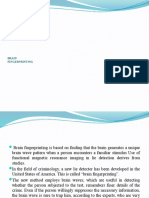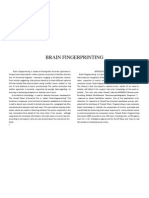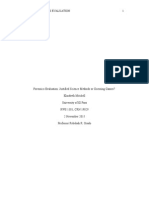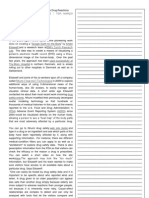Lighting Up The Lies
Lighting Up The Lies
Uploaded by
Dũng HoàngCopyright:
Available Formats
Lighting Up The Lies
Lighting Up The Lies
Uploaded by
Dũng HoàngOriginal Title
Copyright
Available Formats
Share this document
Did you find this document useful?
Is this content inappropriate?
Copyright:
Available Formats
Lighting Up The Lies
Lighting Up The Lies
Uploaded by
Dũng HoàngCopyright:
Available Formats
Reading Practice
Lighting up the lies
A Last year Sean A. Spence, a professor at the school of medicine at the University of
Sheffield in England, performed brain scans that showed that a woman convicted of
poisoning a child in her care appeared to be telling the truth when she denied committing
the crime. This deception study, along with two others performed by the Sheffield group,
was funded by Quickfire Media, a television production company working for the U.K.’s
Channel 4, which broadcast videos of the researchers at work as part of a three-part series
called “Lie Lab.” The brain study of the woman later appeared in the journal European
Psychiatry.
B Functional magnetic resonance imaging (fMRI) purports to detect mendacity by seeing
inside the brain instead of tracking peripheral measures of anxiety—such as changes in
pulse, blood pressure or respiration —measured by a polygraph. Besides drawing
hundreds of thousands of viewers, fMRI has pulled in entrepreneurs. Two
companies—Cephos in Pepperell, Mass., and No Lie MRI in Tarzana, Calif.—claim to
predict with 90 percent or greater certitude whether you are telling the truth. No Lie MRI,
whose name evokes the casual familiarity of a walk-in dental clinic in a strip mall, suggests
that the technique may even be used for “risk reduction in dating” .
C Many neuroscientists and legal scholars doubt such claims—and some even question
whether brain scans for lie detection will ever be ready for anything but more research on
the nature of deception and the brain. An fMRI machine tracks blood flow to activated brain
areas. The assumption in lie detection is that the
brain must exert extra effort when telling a lie and that the regions that do more work get
more blood. Such areas light up in scans; during the lie studies, the illuminated regions are
primarily involved in decision making.
D To assess how fMRI and other neurocience findings affect the law, the Mac- Arthur
Foundation put up $10 million last year to pilot for three years the Law and Neuroscience
Project. Part of the funding will attempt to set criteria for accurate and reliable lie detection
using fMRI and other brain-scanning technology. “I think it’s not possible, given the current
technology, to trust the results,” says Marcus Raichle, a neuroscientist at the Washington
University School of Medicine in St. Louis who heads the project’s study group on lie
detection. “But it’s not impossible to set up a research program to determine whether that’s
possible.” A major review article last year in the American Journal of Law and Medicine by
Henry T. Greely of Stanford University and Judy Illes, now at the University of British
Columbia, explores the deficiencies of existing research and what may be needed to move
the technology forward. The two scholars found that lie detection studies conducted so far
(still less than 20 in all) failed to prove that fMRI is “effective as a lie detector in the real
world at any accuracy level.”
Most studies examined groups, not individuals.Subjects in these studies were healthy
young adults—making it unclear how the results would apply to someone who takes a drug
that affects blood pressure or has a blockage in an artery. And the two researchers
questioned the specificity of the lit-up areas; they noted that the regions also correlate with
a wide range of cognitive behaviors, including memory, self- monitoring and conscious self-
awareness.
The biggest challenge for which the Law and Neuroscience Project is already funding new
Access http://mini-ielts.com for more practices 1
research—is how to diminish the artificiality of the test protocol. Lying about whether a
playing card is the seven of spades may not activate the same areas of the cortex as
answering a question about whether you robbed the comer store. In fact, the most realistic
studies to date may have come from the Lie Lab television programs. The two companies
marketing the technology are not waiting for more data. Cephos is offering scans without
charge to people who claim they were falsely accused if they meet certain criteria in an
effort to get scans accepted by the courts. Allowing scans as legal evidence could open a
potentially huge and lucrative market. “We may have to take many shots on goal before we
actually see a courtroom,” says Cephos chief executive Steven
Laken. He asserts that the technology has achieved 97 percent accuracy and that the more
than 100 people scanned using the Cephos protocol have provided data that have resolved
many of the issues that Greely and Illes cited.
G But until formal clinical trials prove that the machines meet safety and effectiveness
criteria, Greely and Illes have called for a ban on non-research uses. Trials envisaged for
regulatory approval hint at the technical challenges. Actors, professional poker players and
sociopaths would be compared against average Joes. The devout would go in the scanner
after nonbelievers. Testing would take into account social setting. White lies—“no, dinner
really was fantastic”—would have to be compared against untruths about sexual
peccadilloes to ensure that the brain reacts identically.
H There potential for abuse prompts caution. “The danger is that people’s lives can be
changed in bad ways because of mistakes in the technology,” Greely says.
“The danger for the science is that it gets a black eye because of this very high profile use
of neuroimaging that goes wrong.” Considering the long and controversial history of the
polygraph, gradualism may be the wisest course to follow for a new diagnostic that probes
an essential quality governing social interaction.
Access http://mini-ielts.com for more practices 2
Questions 1-7
Use the information in the passage to match the people (listed A-D) with opinions or deeds
below. Write the appropriate letters A-D in boxes 1-7 on your answer sheet.
NB you may use any letter more than once
A Henry T. Greely &Judy Illes
B Steven Laken
c Henry T. Greely
D Marcus Raichle
1..................... The possibility hidden in a mission impossible
2..................... The uncertain effectiveness of functional magnetic resonance imaging for
detecting lies
3..................... The hazard lying behind the technology as a lie detector
4..................... The limited fields for the use of lie detection technology
5..................... Several successful cases of applying the results from the lie detection
technology
6..................... Cons of the current research related to lie-detector tests
7..................... There should be some requested work to improve the techniques regarding
lie detection
Questions 8-10
Do the following statements agree with the information given in Reading Passage?
In boxes 8-10 on your answer sheet, write
TRUE if the statement is true
FALSE if the statement is false
NOT GIVEN if the information is not given in the passage
8..................... The lie detection for a convicted woman was first conducted by researchers
in Europe.
9..................... The legitimization of using scans in the court might mean a promising and
profitable business.
10..................... There is always something wrong with neuroimaging.
Questions 11-13
Access http://mini-ielts.com for more practices 3
Complete the following summary of the paragraphs of Reading Passage, using No More
than Three words from the Reading Passage for each answer. Write your answers in
boxes 11-13 on your answer sheet.
It is claimed that functional magnetic resonance imaging can check lies by observing the
internal part of the brain rather than following up 11..................... to evaluate the anxiety as
12..................... does. Audiences as well as 13..................... are fascinated by this amazing
lie-detection technology.
Access http://mini-ielts.com for more practices 4
Solution:
1. D 8. TRUE
2. A 9. TRUE
3. C 10. NOT GIVEN
4. A 11. PERIPHERAL MEASURES
5. B 12. A POLYGRAPH
6. A 13. ENTREPRENEURS
7. A
Access http://mini-ielts.com for more practices 5
You might also like
- Will We Ever Have A FoolDocument6 pagesWill We Ever Have A FoolTuan Anh TranNo ratings yet
- Detecting DeceptionDocument4 pagesDetecting DeceptionNikhil100% (1)
- Inside The Mind of The ConsumerDocument7 pagesInside The Mind of The ConsumerPhạm Đặng Khánh HàNo ratings yet
- EyeDetect PCSOT 10 5 17Document11 pagesEyeDetect PCSOT 10 5 17Rafael José Fragozo Larrazabal100% (1)
- IRM Brain ForensicDocument3 pagesIRM Brain ForensicCarmen Haidee PelaezNo ratings yet
- Do Criminals Take Advantage by Defending Themselves With Neurological Evidence?Document3 pagesDo Criminals Take Advantage by Defending Themselves With Neurological Evidence?Shu YeeNo ratings yet
- Inside The Mind of The ConsumerDocument5 pagesInside The Mind of The Consumerchugialinh1327No ratings yet
- Red Troll News V1-I4Document21 pagesRed Troll News V1-I4Martin G. SmithNo ratings yet
- Further Practice 3 MatchingDocument14 pagesFurther Practice 3 MatchingTrần Thảo NgânNo ratings yet
- Forensic Analysis in The Digital World: Gary L. Palmer, INFOSEC Scientist The MITRE CorporationDocument6 pagesForensic Analysis in The Digital World: Gary L. Palmer, INFOSEC Scientist The MITRE CorporationDerrick HartNo ratings yet
- Fake It Till You Make ItDocument2 pagesFake It Till You Make Itmraakaash009No ratings yet
- Brain Fingerprinting: Ashwini V. Sharma Dr. Ganesh S. SableDocument7 pagesBrain Fingerprinting: Ashwini V. Sharma Dr. Ganesh S. SableRohan PatelNo ratings yet
- The Truth About Lie Detectors Aka Polygraph TestsDocument4 pagesThe Truth About Lie Detectors Aka Polygraph TestsMălina-Ionela CorlătianuNo ratings yet
- Philosophy 293Document6 pagesPhilosophy 293Matthew RichardsonNo ratings yet
- G T Independent Research Final Draft EssayDocument14 pagesG T Independent Research Final Draft Essayapi-460325872No ratings yet
- Lie Detector That Can Actually Catch You Lying!Document1 pageLie Detector That Can Actually Catch You Lying!toaholidayinthealps1899No ratings yet
- Everything You Wanted To Know About NeuromarketingDocument9 pagesEverything You Wanted To Know About NeuromarketingMuiez HassanNo ratings yet
- Brain FingerDocument16 pagesBrain FingerjenithsweetyNo ratings yet
- Final Draft - How Can Artificial Intelligence Be Used in The Veterinary FieldDocument9 pagesFinal Draft - How Can Artificial Intelligence Be Used in The Veterinary Fieldapi-664351342No ratings yet
- Charlatanry and Fraud: - An Increasing Problem For Forensic Phonetics?Document51 pagesCharlatanry and Fraud: - An Increasing Problem For Forensic Phonetics?emendezgonzalezNo ratings yet
- The Government-Academia Complex and Big Data ReligionDocument8 pagesThe Government-Academia Complex and Big Data ReligionFrancisco AraújoNo ratings yet
- IeeeDocument1 pageIeeeGeethika ReddyNo ratings yet
- Lie Detection FinalDocument17 pagesLie Detection FinalRayudu Priyanka100% (2)
- Nature April 2004Document6 pagesNature April 2004Vineeth Vijayakumara PillaiNo ratings yet
- AI in Medicine, Revised (Merged With p32.1)Document9 pagesAI in Medicine, Revised (Merged With p32.1)xihe.mailboxNo ratings yet
- J Amjmed 2017 10 035Document11 pagesJ Amjmed 2017 10 035Windu KumaraNo ratings yet
- Schweitzer & Saks (2007) CSI EffectDocument9 pagesSchweitzer & Saks (2007) CSI EffectEden SkyeNo ratings yet
- Copyofresearchsection 2Document4 pagesCopyofresearchsection 2api-333870542No ratings yet
- Mmsys2019 Sperm DatasetDocument6 pagesMmsys2019 Sperm DatasetFernando FuentesNo ratings yet
- Layered Voice AnalysisDocument10 pagesLayered Voice AnalysisJack and friendNo ratings yet
- Artificial Intelligence in MedicineDocument8 pagesArtificial Intelligence in MedicineRoger Valle100% (2)
- Thesis On Dna EvidenceDocument7 pagesThesis On Dna EvidenceCustomWritingPapersKnoxville100% (2)
- Harvard Rev PsychiatryDocument8 pagesHarvard Rev PsychiatryMaome76No ratings yet
- Detection of Malingering during Head Injury LitigationFrom EverandDetection of Malingering during Head Injury LitigationArthur MacNeill Horton, Jr.No ratings yet
- Brain FingerprintingDocument16 pagesBrain FingerprintingAnusha GoudNo ratings yet
- Community Problem ReportDocument7 pagesCommunity Problem Reportapi-302721513No ratings yet
- Advances in BiologyDocument11 pagesAdvances in BiologyJean CabigaoNo ratings yet
- ImmunoInformatics Discussion 1Document4 pagesImmunoInformatics Discussion 1biosaran2004No ratings yet
- 6 Big Tech Health Ideas 2012Document5 pages6 Big Tech Health Ideas 2012teteicap59No ratings yet
- 498 2124 1 PB PDFDocument22 pages498 2124 1 PB PDFLyle MurthNo ratings yet
- 61-Article Text-97-1-10-20180117Document27 pages61-Article Text-97-1-10-20180117mad molNo ratings yet
- Innovations in HCIDocument11 pagesInnovations in HCISusana FerencNo ratings yet
- Statistics For Social Science and Public Policy: Springer Science+Business Media, LLCDocument453 pagesStatistics For Social Science and Public Policy: Springer Science+Business Media, LLCRaj KumarNo ratings yet
- Machine Learning Evidence - Admissibility and WeightDocument40 pagesMachine Learning Evidence - Admissibility and Weight22lawc1043231No ratings yet
- Spring 2003 Edition: Brain FingerprintingDocument4 pagesSpring 2003 Edition: Brain FingerprintingPriya BakkyNo ratings yet
- Google Earth For The Bod Andre Elisseeff IBM S Zurich Research LabDocument2 pagesGoogle Earth For The Bod Andre Elisseeff IBM S Zurich Research LabLuiz AurélioNo ratings yet
- Deep Learning in Lie Detector and Brain FingerprintingDocument11 pagesDeep Learning in Lie Detector and Brain FingerprintingSHUBHANGI SHARMANo ratings yet
- Lecture No. 1. Ethical DIlemmas FINALDocument4 pagesLecture No. 1. Ethical DIlemmas FINALEdelberto N. Anilao IIINo ratings yet
- Tools of InterogationDocument13 pagesTools of InterogationLAKHVEER SINGHNo ratings yet
- You Cannot Be Serious! Public Understanding of Technology With Special Reference To 'Hawk-Eye.'Document59 pagesYou Cannot Be Serious! Public Understanding of Technology With Special Reference To 'Hawk-Eye.'aampata69No ratings yet
- TheyThinkThey KnowDocument7 pagesTheyThinkThey KnowjpkaerfNo ratings yet
- Farwell Smith Journal of Forensic Sciences Brain FingerprintingDocument10 pagesFarwell Smith Journal of Forensic Sciences Brain FingerprintingPARVATHY SUNILNo ratings yet
- Brain Fingerprinting: Full Length Research PaperDocument6 pagesBrain Fingerprinting: Full Length Research PaperhitmanamitNo ratings yet
- Polygraph Tests - Benefits and ChallengesDocument10 pagesPolygraph Tests - Benefits and ChallengesahmedNo ratings yet
- Brain Scans Look Stunning, But What Do They Actually Mean - Psyche IdeasDocument6 pagesBrain Scans Look Stunning, But What Do They Actually Mean - Psyche IdeasCamiloAndrésGarzónNo ratings yet
- Final Draft Annotated BibliographyDocument7 pagesFinal Draft Annotated Bibliographyapi-478782236No ratings yet
- Forensic Science Masters Thesis TopicsDocument7 pagesForensic Science Masters Thesis Topicsijofwkiig100% (2)
- Pros and Cons of Statistical Sampling Law360 2011Document5 pagesPros and Cons of Statistical Sampling Law360 2011leulNo ratings yet
- Syllabus TrangDocument1 pageSyllabus TrangDũng HoàngNo ratings yet
- Ielts Reading Actual Test by Ielts SupportDocument235 pagesIelts Reading Actual Test by Ielts SupportDũng HoàngNo ratings yet
- T V NG Cho Lan Anh Và Cư NGDocument2 pagesT V NG Cho Lan Anh Và Cư NGDũng HoàngNo ratings yet
- Revolutions in MappingDocument5 pagesRevolutions in MappingMinh VũNo ratings yet
- The Fluoridation ControversyDocument5 pagesThe Fluoridation ControversyDũng HoàngNo ratings yet
- ĐỀ SỐ 17-HSG ANH 9.doc chữa lần 2Document8 pagesĐỀ SỐ 17-HSG ANH 9.doc chữa lần 2Dũng HoàngNo ratings yet
- ĐỀ SỐ 15-HSG ANH 9.doc-trang chữa còn bài nghe đọcDocument8 pagesĐỀ SỐ 15-HSG ANH 9.doc-trang chữa còn bài nghe đọcDũng HoàngNo ratings yet
- IELTS VOCABULARY TransportationDocument2 pagesIELTS VOCABULARY TransportationDũng HoàngNo ratings yet
- Exploring-British-Village-2 (1) - Trang-1-4 Đã S ADocument4 pagesExploring-British-Village-2 (1) - Trang-1-4 Đã S ADũng HoàngNo ratings yet
- ĐỀ SỐ 13-HSG ANH 9.doc hết toàn bộDocument7 pagesĐỀ SỐ 13-HSG ANH 9.doc hết toàn bộDũng HoàngNo ratings yet
- Honey Bees in TroubleDocument6 pagesHoney Bees in TroubleDũng HoàngNo ratings yet
- Đề số 16 đã chữa xong hếtDocument8 pagesĐề số 16 đã chữa xong hếtDũng HoàngNo ratings yet
- Official TranscriptsDocument1 pageOfficial TranscriptsDũng HoàngNo ratings yet
- Đề trại hè Phương NamDocument17 pagesĐề trại hè Phương NamDũng HoàngNo ratings yet
- The Pesticide Free VillageDocument5 pagesThe Pesticide Free VillageDũng HoàngNo ratings yet
- In Class Checkpoint Quiz ManaeconDocument17 pagesIn Class Checkpoint Quiz ManaeconDũng HoàngNo ratings yet
- Origin of PaperDocument4 pagesOrigin of PaperDũng HoàngNo ratings yet
- Seating Arrangement and Puzzle Questions 341144Document5 pagesSeating Arrangement and Puzzle Questions 341144प्रबोधNo ratings yet
- C3 1 Exe Quality ToolsDocument9 pagesC3 1 Exe Quality ToolsHy CaoNo ratings yet
- Jurnal Krisna Wardana Apload - CompressedDocument19 pagesJurnal Krisna Wardana Apload - CompressedKrisna WardanaNo ratings yet
- Deforestation Dissertation IdeasDocument7 pagesDeforestation Dissertation Ideasdipsekator1983100% (1)
- Non Traditional Methods For Teaching Chemistry at Hich SchoolDocument28 pagesNon Traditional Methods For Teaching Chemistry at Hich Schoolak19555581No ratings yet
- 02 - Dividing Polynomials-2Document4 pages02 - Dividing Polynomials-2mheojhun100% (1)
- Aqueous Liquid Repellency: Water/Alcohol Solution Resistance TestDocument3 pagesAqueous Liquid Repellency: Water/Alcohol Solution Resistance TestAbraham ToxtleNo ratings yet
- BSG002A BattlestarGalactica FasterThanLight PNP enDocument44 pagesBSG002A BattlestarGalactica FasterThanLight PNP enTransbugoy100% (1)
- 2013-02-05 - MAA - Santhosh - Historic Buildings in India With Energy Efficient StrategiesDocument22 pages2013-02-05 - MAA - Santhosh - Historic Buildings in India With Energy Efficient StrategiesbarathiNo ratings yet
- Module 1 Introduction To Highway and Railroad EngineeringDocument43 pagesModule 1 Introduction To Highway and Railroad EngineeringKenneth FajardoNo ratings yet
- 07 ManualDocument34 pages07 ManualShivraj NaikNo ratings yet
- Operatio Research For Chemical EngineeringDocument6 pagesOperatio Research For Chemical Engineeringmohamed refaatNo ratings yet
- Early Childhood Education ResumeDocument6 pagesEarly Childhood Education Resumenjoqvnjbf100% (2)
- 9 (1) .Leontief Paradox and Development of Trade TheoryDocument35 pages9 (1) .Leontief Paradox and Development of Trade TheoryWishy Khan100% (1)
- UIUC RASC-AL Technical ReportDocument36 pagesUIUC RASC-AL Technical ReportBrody LauerNo ratings yet
- Statistics Word Search 4: Name: - DateDocument4 pagesStatistics Word Search 4: Name: - DatePhoebe Imee ThomasNo ratings yet
- Module 4 Student NotesDocument34 pagesModule 4 Student Notessharang IngawaleNo ratings yet
- Guide - PS LabelDocument9 pagesGuide - PS LabelSundar MoorthiNo ratings yet
- BensonandJordan IESBS2e.2015Document8 pagesBensonandJordan IESBS2e.2015SarahLNo ratings yet
- Fd308-m Load Table PDFDocument1 pageFd308-m Load Table PDFVictor IkeNo ratings yet
- HCI Chapter 5Document87 pagesHCI Chapter 5SohailNo ratings yet
- The Impact of Safety Behaviour Nurses, Work Stress, Skill Competency and Hospital Commitment in Hajj JakartaDocument8 pagesThe Impact of Safety Behaviour Nurses, Work Stress, Skill Competency and Hospital Commitment in Hajj JakartaCentral Asian StudiesNo ratings yet
- ME-270 Spring21 ProjectDocument5 pagesME-270 Spring21 Projecthaseeb ahmedNo ratings yet
- KBS-aided Design of Tube Bending Processes PDFDocument8 pagesKBS-aided Design of Tube Bending Processes PDFkiranNo ratings yet
- Graphic DesignDocument5 pagesGraphic DesignMichaela SalvañaNo ratings yet
- Lipase (S.L) : ADL/V.02/060114Document1 pageLipase (S.L) : ADL/V.02/060114Aniket dubeyNo ratings yet
- Add Info B-64305EN 03Document4 pagesAdd Info B-64305EN 03Denis Villanueva PerezNo ratings yet
- Activity 2.3.1 Animal Needs: PurposeDocument3 pagesActivity 2.3.1 Animal Needs: PurposeJayden DodgeNo ratings yet
- The New Urbanism (Part 2) I. The StreetDocument20 pagesThe New Urbanism (Part 2) I. The StreetKhiara May FabulaNo ratings yet
- Soalan Halus Struktur Atom PDFDocument30 pagesSoalan Halus Struktur Atom PDFNur Irdina HaniNo ratings yet










































































































